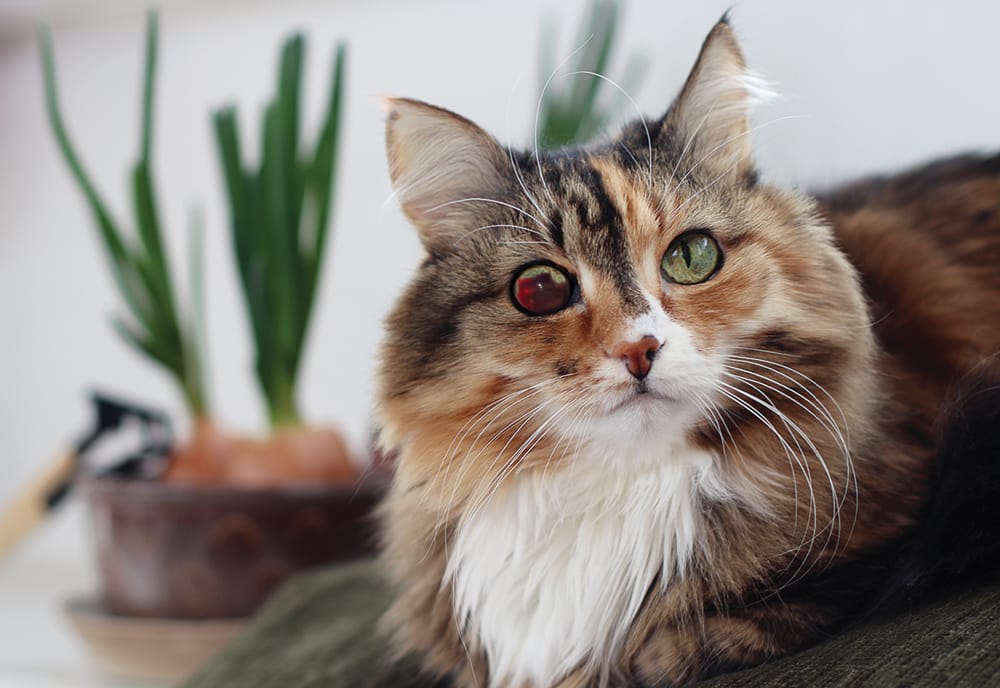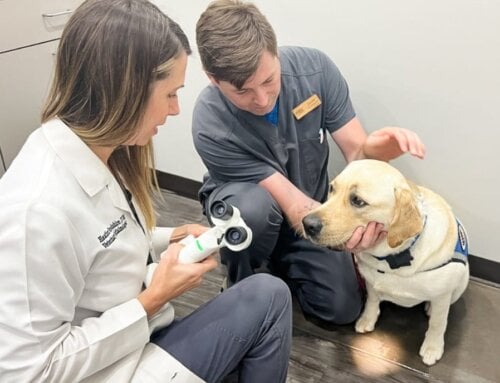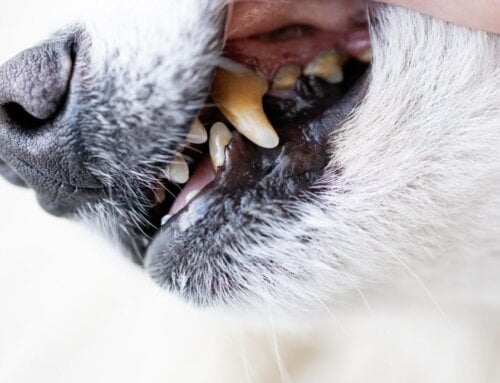By Amanda Romaneck, DVM, Ophthalmology Resident
You or someone you know may have hypertension, also known as high blood pressure. But did you know that dogs and cats can be diagnosed with this condition too?
Systemic hypertension happens when there is a persistent elevation in one or all blood pressure parameters (systolic/diastolic/mean). This affects how much the heart has to work to move blood throughout the body. When it occurs without a known cause, it is referred to as primary hypertension. When it is associated with an underlying disease, it is referred to as secondary hypertension.
Typically, our furry friends get secondary hypertension rather than primary. In dogs, this is commonly due to complications of renal disease, hyperadrenocorticism (Cushing’s disease), diabetes mellitus, pheochromocytoma, and hypothyroidism, among other less common endocrine diseases.
Older cats, above the age of 11 years old, can develop systemic hypertension due to chronic renal failure and hyperthyroidism. Other conditions that can result in feline hypertension diagnosis include diabetes mellitus, chronic anemia, heart disease (hypertrophic cardiomyopathy), high-salt diet, and other endocrine diseases.
Clinical signs of hypertension
So how do you know if your pet has hypertension? The clinical signs can vary and depend on the specific component of the eye that is affected. Signs to monitor in dogs and cats include:
- Hemorrhage within the eye (more obvious if it is in the front of the eye, but it can also occur in the back)
- Dilated pupils and/or decline in vision.
- Retinal detachments
- Sudden change in vision
It’s important to note that changes caused by systemic hypertension can be severe and lead to blindness, if untreated. If high blood pressure can be controlled before severe ocular changes occur, the pet’s vision can be spared.
When taking a blood pressure reading at our practice, we make it as comfortable as we can for our patients. Instead of using a stethoscope to listen for the pulses, we use a special Doppler probe to amplify the sound.
Similar to people, dogs and cats have a normal range for their blood pressure measurements. Doctors like their human patients to have a blood pressure around 120mmHg (systolic)/80mmHg (diastolic). This would also be ideal for our four-legged companions. We give them a little buffer, however, because it can be stressful for some pets to be in a clinical setting.
Treating high blood pressure
Treating high blood pressure requires the pet to start oral antihypertensive medications to help bring their blood pressure within the normal range. Often, these medications will be taken life-long and are needed to help prevent damage to target organs, such as the eyes, kidneys, brain, and heart.
If the pet experiences changes to their eyes due to high blood pressure, we may recommend specific therapies for the eye(s) to help preserve their vision and comfort. This can include eye drops or ointments, as well as other oral medications to reduce inflammation.
Hypertension can be a result of other diseases as well. Therefore it is important for dogs or cats to undergo diagnostic tests to determine if there is an underlying cause. This can include a blood cell count, chemistry panel and a urinalysis to evaluate the pet’s organ function. The pet’s veterinarian may propose additional tests, depending on other problems they may be experiencing. If an underlying cause is found, treatment for the cause may be recommended along with antihypertensive therapy. To ensure the pet’s blood pressure is controlled, regular measurements should be performed with a veterinarian.
For additional information and images, please see our “Hypertension and the Eye” brochure in our Virtual Library. If your dog or cat is experiencing any signs of high blood pressure, please call us to schedule an appointment at (757) 749-4838.
Visit our virtual library to learn more about Hypertension and the Eye
















